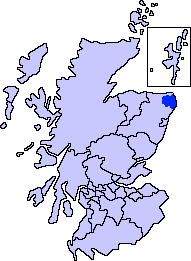
Buchan is a coastal district in the north-east of Scotland, bounded by the Ythan and Deveron rivers. It was one of the original provinces of the Kingdom of Alba. It is now one of the six committee areas of Aberdeenshire.

Cruden Bay is a small village in Scotland, on the north coast of the Bay of Cruden in Aberdeenshire, 26 miles (42 km) north of Aberdeen.

Mintlaw Academy is a secondary school in Aberdeenshire, Scotland.

The River Ugie or Ugie Water is a river in North East Scotland; it flows into the North Sea on the east coast at Peterhead, north of Cruden Bay. There is considerable evidence of prehistoric settlement within the Ugie drainage basin, especially in the South Ugie Water catchment basin. For example, the Catto Long Barrow is found somewhat to the south of the Ugie Water mainstem.
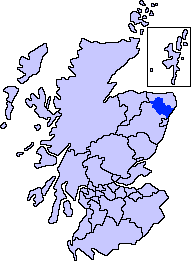
Formartine is a committee area in Aberdeenshire, Scotland. This district extends north from the River Don to the River Ythan. It has a population of 36,478.

Maud is a village in the Buchan area of the Scottish county of Aberdeenshire, with a population of 780. Located 13 miles (21 km) west of Peterhead on the South Ugie Water, Maud rose to prosperity after 1863 as a railway junction of the Formartine and Buchan Railway that ran through Maud to Fraserburgh and Peterhead, but has always been the meeting place of six roads. It has had a variety of names:

The name Bullers of Buchan refers both to a collapsed sea cave and to the adjacent village, situated about 6 miles (9.7 km) south of Peterhead in Buchan, Aberdeenshire, Scotland.

Buchanhaven is a village in Aberdeenshire, Scotland, dating to around 1739. It is one mile north of Peterhead town centre, and near to the mouth of the River Ugie. It has its own school, Buchanhaven Primary School, which caters for children in Buchanhaven and the nearby Waterside estate. It is also the home of Buchanhaven Hearts F.C.

Deer Abbey was a Cistercian monastery in Buchan, Scotland. It was founded by 1219 under the patronage William Comyn, jure uxoris Earl of Buchan, who is also buried there.

New Deer is a settlement in Aberdeenshire, North East Scotland, which lies in the valley of Deer. It is located at the junction of several roads crossing through the Howe of Buchan. It was founded after monks from Deer Abbey, Old Deer, built a chapel at Auchreddie, which translates as "field of the bog myrtle", and lies clustered on both sides of the slope of a tributary of South Ugie Water. Around 1507 the register of Deer Abbey lists its lands in the "new paroche of Deir". The name Auchreddie has dropped in significance over the years; however, the southern end of the village is still known by this name.

Mintlaw(literally meaning a smooth, flat place) is a large village in Aberdeenshire, Scotland lying along the A952 road and is geographically a route centre. The 2001 UK census records a population of 2,647 people.

Longside is a village located in Aberdeenshire, Scotland, consisting of a single main street. It lies seven miles inland from Peterhead and two miles from Mintlaw on the A950. Its population in 2001 was 721. The River Ugie flows through it.
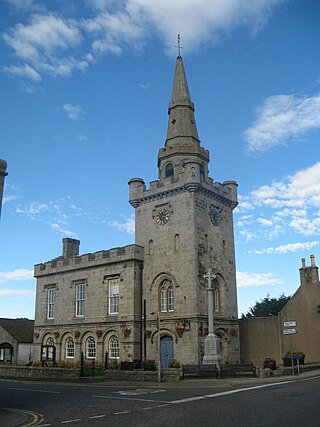
Strichen is a village in Aberdeenshire, Scotland. It sits on the A981, connecting it to New Deer 7.2 miles (12 km) to the southwest and Fraserburgh 8 miles (13 km) to the north-northeast, and the B9093, connecting it to New Pitsligo about 4 miles (6.4 km) due west. The village got its name from Lord Strachen. It is situated on the River Ugie at the foothills of Mormond Hill. The Strichen White Horse is constructed of quartz on Mormond Hill, some 1,500 m (1,600 yd) northeast of Strichen.
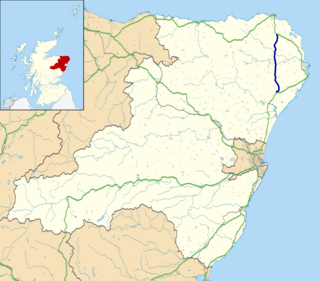
The A952 road is a main road in Aberdeenshire, Scotland. This roadway is a north–south connector that serves as an inland bypass to the more coastally aligned A90 road. It runs from Toll of Birness in the south to Cortes in the north, passing through the communities of Ardallie, Clola, Mintlaw and New Leeds. It has been noted that traffic accidents are most frequent at pronounced road bends along the A952.

Hatton is a village in Aberdeenshire, Scotland that lies on the A90 road, approximately equidistant from both Ellon and Peterhead.

St Combs is a small fishing village in Aberdeenshire, Scotland, immediately southeast of Inverallochy. It has existed since at least the 17th century, and takes its name from a church to St Colm that used to exist in the area and was abandoned in 1607. Only a fragment of it remains. The remains of Lonmay Castle are also in the area. The village sits across Loch Strathbeg from Rattray.
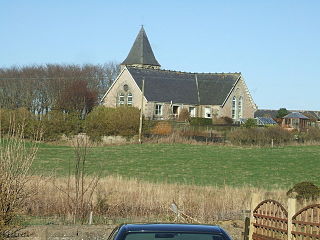
Clola is a hamlet in Buchan, Aberdeenshire, Scotland. Clola is situated on the A952 road. There is considerable evidence of local habitation by early man in the vicinity of Clola. Some of these nearby human traces are evident in Catto Long Barrow, a massive stone structure now surrounded by agricultural fields.

New Leeds is a planned village in the Buchan area of Aberdeenshire, Scotland, situated 5.1 kilometres (3.2 mi) east of Strichen at the foot of Mormond Hill.

James Ferguson FRSE was a Scottish advocate and Tory politician and the third Laird of Pitfour, a large estate in the Buchan area of north east Scotland, which is known as the 'Blenheim of the North'.

The Pitfour Estate, in the Buchan area of North-East Scotland, was an ancient barony encompassing most of the extensive Longside Parish, stretching from St Fergus to New Pitsligo. It was purchased in 1700 by James Ferguson of Badifurrow, who became the first Laird of Pitfour.






















